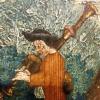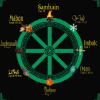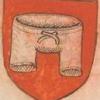Примеры можно привести ?
Я имею в виду не самосуд, а именно жертвоприношения.
Вот. Правда, можно говорить подборка тенденцизная (автор книги-немец, соответсвенно все случаи взяты из работ французов и немцев, которые матушку Россию в 19м веке жаловали не сильно, потомучто боялись), но автор книжки находит подобные случаи в сравнимом количестве и в Европе, причем большинство - в сельских местностях. Там, кстати, есть большой привет Елене Балашовой - раздел про то, что делали с трупами "незабитые крестьяне".
Собственно, книжка, несмотря на неполиткорректное название ("Евреи и человеческое жертвоприношение") для своего времени весьма прогрессивная и объективная. Правда, объективность эта выходит боком: с одной стороны, автор убедительно доказывает, что РИТУАЛОВ человеского жертвоприношения у евреев в религии нет, а с другой - находит такое количество кровожадных СУЕВЕРИЙ у других народов, что вероятность того, что какие-то убийства действительно совершались из суеверия еврейскими сектантами резко стремится к единице.
Для реконструкторов ценна подробным перечислением средневековых упоминаний "ритуальных убийств" и списком средневековых же рабоблачений для многих из них.
http://www.archive.o...nsacrific00straThe following events are to be considered as
rela'pses into heathendom or as survivals from heathen
times. About two hundred versts (kms.) from Kasan
is the village of Stary-Multan, whose inhabitants
belong to the Russian Orthodox Church, with a
church and a priest. Owing to bad harvests, famine
and typhus visited them in 1892, and there was a fear
of cholera. They began to doubt whether their way
of worshipping God was the right. They thought
they must appease the supernatural powers by sacri-
fice. Animal sacrifices helped nothing. Whereupon
a sage of the village received the revelation that a
"two-legged" sacrifice (kurban) was required, that
is, a human sacrifice. There lived in the village a
man from another district, so that he was without
relations and friends in the place itself. This unfor-
tunate man, on 4th (16th) May, 1892, was dragged into
the Town Hall, stripped there, and hung up by his
feet to the ceiling, and then fifteen persons with
knives began to stab at his naked body. The blood
streaming from the wounds was carefully caught in
vessels, cooked and drunk by the sacrifice rs. The
lunQS and heart were also consumed. The village
magistrate, the peasant-born policeman, and the chief
elder of the church took part in the ceremony. The
people were so convinced of the righteousness of their
action that they did not take the least pains to con-
ceal the murder. So it soon came to the knowledge
of the authorities. After two and a half years the
trial came to an end, and the perpetrators of the ritual
murder were condemned to many years' hard labour.
(UrqueU, 1897, 118 sq., after the Freies Blatt, Vienna,
13 Jan., 1895, No. 145).
Government of Minsk, district of Nowogrud. In
1831 the country people, during a cholera epidemic,
wanted to bury a priest alive ; he only saved himself
by begging his parishioners for a respite, in order to
prepare for death. In August, 1855, the inhabitants
of the village of Okopowitschi, in a similar epidemic,
on the advice of an army surgeon Kosakowitsch,
pushed an old woman, Lucia Manjkow, alive, as a
sacrifice, into a pit, in which there were already
corpses, and then quickly heaped earth upon it. In
August, 1871, the inhabitants of the village of Tor-
katschi wanted to inflict the same fate on an invalid
peasant woman; her husband and son-in-law came
only just in time to the rescue ; it is said that another
woman who was ill, and by herself, was then sacri-
ficed alive. The whole of the village authorities
shared the conviction that they could save them-
selves from the cholera by the burying of a living
person. In the Turuchan district, government
Jenissei, a peasant P., by descent a Russian, buried
alive, in 1861, a girl akin to him in order to save
himself and his family from a prevalent epidemic
disease by the sacrifice {Lowenstimm, 12-14).
A Samoyede, Jefrem Pyrerka, strangled in Nova
Zembla, duringr the famine of the winter of 1881, a
girl, Ssavanei, in order, as he openly stated, to bring
an offering to the devil, because God, in whom he
believed, did not help him in the time of the famine.
Later he fashioned a wooden idol and wanted to sacri-
fice to it his tent comrade, Andrei Tabarei; he threw
a noose round his neck, and only the entrance of P.'s
wife saved Andrei from death (Lowenstimm, 10).


















